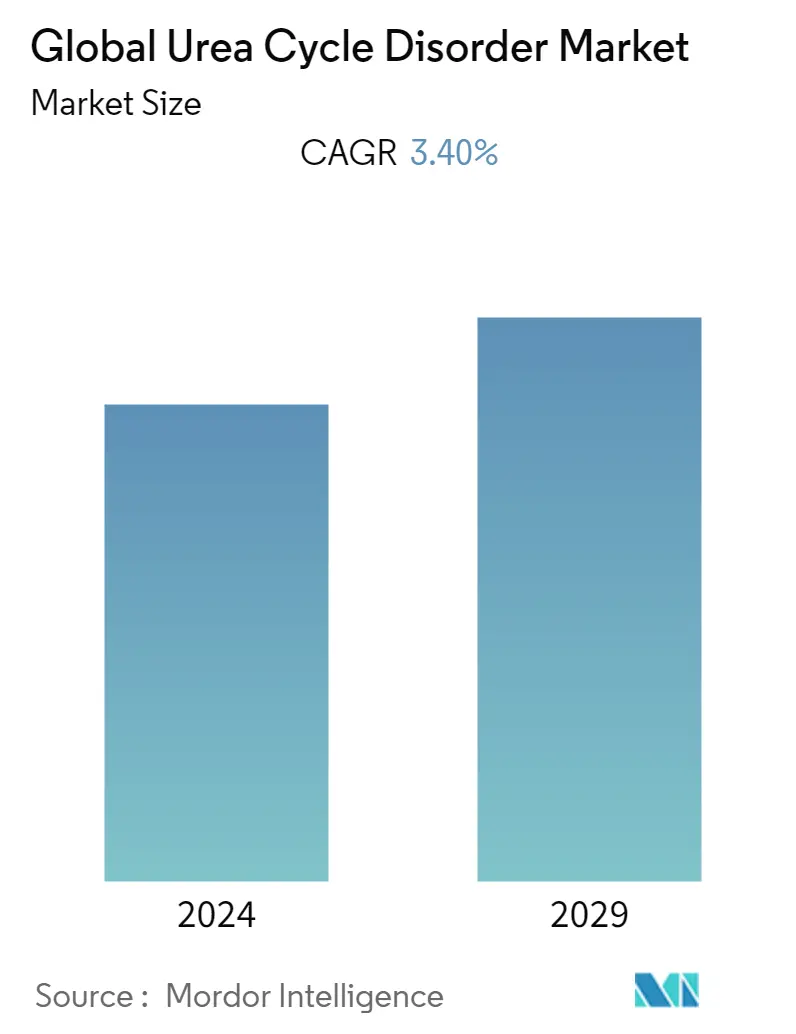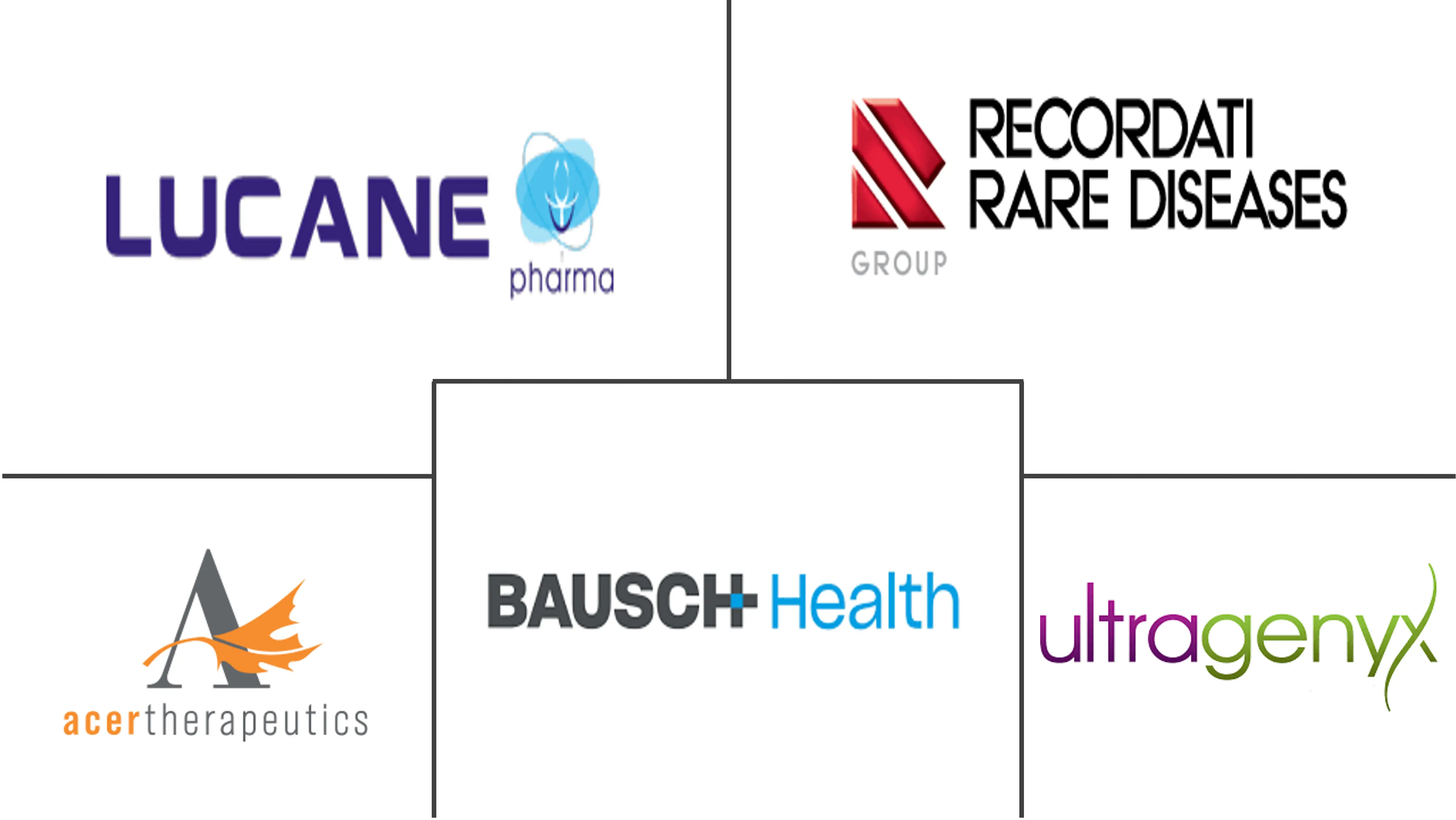Market Size of Global Urea Cycle Disorder Industry

| Study Period | 2019 - 2029 |
| Base Year For Estimation | 2023 |
| Forecast Data Period | 2024 - 2029 |
| CAGR | 3.40 % |
| Fastest Growing Market | Asia-Pacific |
| Largest Market | North America |
Major Players
*Disclaimer: Major Players sorted in no particular order |
Urea Cycle Disorder Market Analysis
The Urea Cycle Disorder Market is expected to grow at a significant CAGR of 3.4% during the study period (2022-2027).
In recent times, countries have faced a huge threat of COVID-19. According to the World Health Organization (WHO), coronavirus is an infectious disease, and most people infected with the COVID-19 virus will experience mild to moderate respiratory illness.
The emergence of the COVID-19 pandemic harmed the world economy and the healthcare system. The article 'Longitudinal Metabolomics Reveals Ornithine Cycle Dysregulation Correlates With Inflammation and Coagulation in COVID-19 Severe Patients,' published in December 2021, identified that the ornithine cycle dysregulation is significantly correlated with inflammation and coagulation in severe patients, which may be a potential mechanism of COVID-19 pathogenicity. Therefore, the COVID-19 medications hampered the urea cycle, leading to a deficiency of certain enzymes. Hence, there is an increasing demand for its therapeutics, contributing to market growth.
However, the production of these drugs was hampered due to the temporary lockdown in the manufacturing plants, shortage of skilled labor, and increasing cases of COVID-19 inside the manufacturing plants, which has led to outages, thus, impacting the market. Hence, the above factors indicate that COVID-19 significantly impacted the studied market.
The factors propelling the studied market growth are the rising prevalence of urea cycle disorders and the increasing number of pipeline products. Product launches, approvals, and strategic initiatives by key market players are expected to contribute to significant market growth.
Hyperammonemia is a metabolic condition characterized by raised ammonia levels, a nitrogen-containing compound. Consequently, urea cycle disorders lead to an accumulation of ammonia. Ammonia is extremely toxic, particularly to the central nervous system. As per the article published in Statpearls in November 2021, the prevalence of ornithine transcarbamylase deficiency-led urea cycle disorder is estimated to be 1in 140,000 people. It is the most common type of urea cycle disorder. Although it is a rare disease, its prevalence, if found to increase, thereby effective therapeutics are demanded, thus, driving the market.
Additionally, research and development studies highlighting the genetic characterization of urea cycle disorders will help market players align their product development, contributing to market growth. For instance, the study titled 'Clinical and Genetic Characterization and Biochemical Correlation at Presentation in 48 Patients Diagnosed with Urea Cycle Disorders at the Hospital Juan P Garrahan, Argentina,' published in September 2021, demonstrated that patients with early onset of the disease suffer the most severe forms and still have high morbimortality. At the same time, patients with late-onset are less severe and finally diagnosed due to one or more acute episodes.
Moreover, strategic initiatives such as partnerships, expansions, and acquisitions will also lead to significant market growth. For instance, in October 2021, Boehringer Ingelheim and Thoeris GmbH announced a collaboration and license agreement to investigate novel first-in-class therapies for patients with urea cycle disorders (UCDs). Such partnership will help players leverage their expertise and expand their product offerings, thus propelling the market.
Therefore, owing to the factors mentioned above, the studied market is expected to grow significantly during the study period. However, the high cost of therapeutics is expected to hinder the market growth during the forecast period.
Urea Cycle Disorder Industry Segmentation
As per the scope of the report, urea cycle disorders are inborn errors of metabolism resulting from defects in one of the enzymes or transporter molecules involved in the hepatic removal of ammonia from the bloodstream. The Urea Cycle Disorder Market is Segmented by Treatment Type (Amino Acid Supplements, Sodium Phenylbutyrate, Glycerol Phenylbutyrate, Sodium Benzoate, and Others (Low Protein Diet, Carglumic Acid, etc.)), by Enzyme Deficiency Type (Ornithine Transcarbamylas (OTC), Argininosuccinate Synthetase (citrullinemia) (AS), Arginase (AG), Argininosuccinate Lyase (AL), Carbamoyl Phosphate Synthase (CPS1), and N-acetyl glutamate Synthase (NAGS)), by Route of Administration (Oral and Injectables), and by Geography (North America, Europe, Asia Pacific, and Rest of the World). The market report also covers the estimated market sizes and trends for 17 countries across major global regions. The report offers the value (in USD million) for the above segments.
| By Treatment Type | |
| Amino Acid Supplements | |
| Sodium Phenylbutyrate | |
| Glycerol Phenylbutyrate | |
| Sodium Benzoate | |
| Others (Low Protein Diet, Carglumic Acid, etc.) |
| By Enzyme Deficiency Type | |
| Ornithine Transcarbamylas (OTC) | |
| Argininosuccinate Synthetase (citrullinemia) (AS) | |
| Arginase (AG) | |
| Argininosuccinate Lyase (AL) | |
| Carbamoyl Phosphate Synthase (CPS1) | |
| N-acetylglutamate Synthase (NAGS) |
| By Route of Administration | |
| Oral | |
| Injectable |
| Geography | ||||||||
| ||||||||
| ||||||||
| ||||||||
| Rest of the World |
Global Urea Cycle Disorder Market Size Summary
The Urea Cycle Disorder Market is poised for significant growth, driven by the increasing prevalence of urea cycle disorders and a robust pipeline of therapeutic products. The market's expansion is supported by strategic initiatives such as product launches, approvals, and collaborations among key players. Despite the challenges posed by the COVID-19 pandemic, which temporarily disrupted drug production and highlighted the need for effective therapeutics, the market is expected to recover and thrive. The demand for therapeutics is further fueled by the toxic accumulation of ammonia in urea cycle disorders, particularly ornithine transcarbamylase deficiency, which is the most common type. Research and development efforts focusing on genetic characterization and novel therapies are anticipated to align product development with market needs, contributing to the market's growth trajectory.
In North America, the market is expected to experience lucrative growth due to the high prevalence of urea cycle disorders and the introduction of innovative treatments. The United States, in particular, is projected to hold a significant market share, driven by the demand for diagnostics and therapeutics to address the burden of these disorders. The market's competitive landscape is characterized by the presence of major players such as Bausch Health Companies Inc., Recordati Rare Diseases, and Acer Therapeutics, who are actively engaged in strategic partnerships and product development. Regulatory approvals and ongoing research activities are expected to enhance the adoption of existing and new therapeutics, further propelling market growth. Despite the high cost of therapeutics posing a potential barrier, the overall outlook for the urea cycle disorder market remains positive, with significant growth anticipated during the forecast period.
Global Urea Cycle Disorder Market Size - Table of Contents
-
1. MARKET DYNAMICS
-
1.1 Market Overview
-
1.2 Market Drivers
-
1.2.1 Rising Prevalence of Urea Cycle Disorders
-
1.2.2 Increasing Number of Pipeline Products
-
-
1.3 Market Restraints
-
1.3.1 High Cost of Therapeutics
-
-
1.4 Porter's Five Forces Analysis
-
1.4.1 Threat of New Entrants
-
1.4.2 Bargaining Power of Buyers/Consumers
-
1.4.3 Bargaining Power of Suppliers
-
1.4.4 Threat of Substitute Products
-
1.4.5 Intensity of Competitive Rivalry
-
-
-
2. MARKET SEGMENTATION (Market Size by Value - in USD Million)
-
2.1 By Treatment Type
-
2.1.1 Amino Acid Supplements
-
2.1.2 Sodium Phenylbutyrate
-
2.1.3 Glycerol Phenylbutyrate
-
2.1.4 Sodium Benzoate
-
2.1.5 Others (Low Protein Diet, Carglumic Acid, etc.)
-
-
2.2 By Enzyme Deficiency Type
-
2.2.1 Ornithine Transcarbamylas (OTC)
-
2.2.2 Argininosuccinate Synthetase (citrullinemia) (AS)
-
2.2.3 Arginase (AG)
-
2.2.4 Argininosuccinate Lyase (AL)
-
2.2.5 Carbamoyl Phosphate Synthase (CPS1)
-
2.2.6 N-acetylglutamate Synthase (NAGS)
-
-
2.3 By Route of Administration
-
2.3.1 Oral
-
2.3.2 Injectable
-
-
2.4 Geography
-
2.4.1 North America
-
2.4.1.1 United States
-
2.4.1.2 Canada
-
2.4.1.3 Mexico
-
-
2.4.2 Europe
-
2.4.2.1 Germany
-
2.4.2.2 United Kingdom
-
2.4.2.3 France
-
2.4.2.4 Italy
-
2.4.2.5 Spain
-
2.4.2.6 Rest of Europe
-
-
2.4.3 Asia-Pacific
-
2.4.3.1 China
-
2.4.3.2 Japan
-
2.4.3.3 India
-
2.4.3.4 Australia
-
2.4.3.5 South Korea
-
2.4.3.6 Rest of Asia-Pacific
-
-
2.4.4 Rest of the World
-
-
Global Urea Cycle Disorder Market Size FAQs
What is the current Global Urea Cycle Disorder Market size?
The Global Urea Cycle Disorder Market is projected to register a CAGR of 3.40% during the forecast period (2024-2029)
Who are the key players in Global Urea Cycle Disorder Market?
Bausch Health Companies Inc., Recordati Rare Diseases, Eurocept Pharmaceuticals Holding (Lucane Pharma SA), Acer Therapeutics and Ultragenyx Pharmaceutical are the major companies operating in the Global Urea Cycle Disorder Market.

